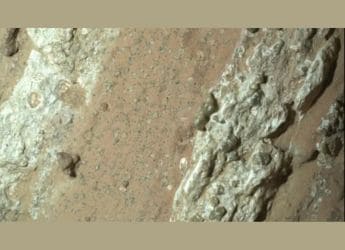- Home
- Science
- Science News
- NASA's Spritzer Telescope Completes 15 Years in Space
NASA's Spritzer Telescope Completes 15 Years in Space

Photo Credit: NASA/JPL-Caltech/Harvard-Smithsonian CfA
This image from Spitzer shows newborn stars peeking out from beneath their natal blanket of dust
NASA's Spitzer Space Telescope, the youngest member of the "Great Observatory" programme, has completed 15 years in space.
The Great Observatories are four big-ticket space telescopes - Spitzer, Hubble Space Telescope, the Compton Gamma Ray Observatory (CGRO), and the Chandra X-ray Observatory - designed to view the universe in different and complementary wavelengths of light.
Launched into solar orbit on August 25, 2003, Spitzer was initially scheduled for a minimum 2.5-year primary mission. But the space telescope has lasted far beyond its expected lifetime, the US space agency said in a statement.
"In its 15 years of operations, Spitzer has opened our eyes to new ways of viewing the universe," said Paul Hertz, director of the Astrophysics Division at NASA Headquarters in Washington.
"Spitzer's discoveries extend from our own planetary backyard, to planets around other stars, to the far reaches of the universe. And by working in collaboration with NASA's other Great Observatories, Spitzer has helped scientists gain a more complete picture of many cosmic phenomena," he added.
Celebrating Spitzer's incredible discoveries and amazing images, NASA has also released two new multimedia products: The NASA Selfies app for iOS and Android, and the Exoplanet Excursions VR Experience for Oculus and Vive, as well as a 360-video version for smartphones, the statement said.
Spitzer has logged over 106,000 hours of observation time in the past 15 years.
It has illuminated some of the oldest galaxies in the universe, revealed a new ring around Saturn, and peered through shrouds of dust to study newborn stars and black holes.
The space telescope also assisted in the discovery of planets beyond our solar system, including the detection of seven Earth-size planets orbiting the star TRAPPIST-1, among other accomplishments.
Spitzer orbits the Sun in an Earth-trailing orbit (meaning it literally trails behind Earth as the planet orbits the Sun) and has continued to fall farther and farther behind Earth during its lifetime.
In 2016, Spitzer entered an extended mission dubbed "Spitzer Beyond". The spacecraft is currently scheduled to continue operations into November 2019, more than 10 years after entering its warm phase, the statement noted.
Get your daily dose of tech news, reviews, and insights, in under 80 characters on Gadgets 360 Turbo. Connect with fellow tech lovers on our Forum. Follow us on X, Facebook, WhatsApp, Threads and Google News for instant updates. Catch all the action on our YouTube channel.
Related Stories
- Samsung Galaxy Unpacked 2025
- ChatGPT
- Redmi Note 14 Pro+
- iPhone 16
- Apple Vision Pro
- Oneplus 12
- OnePlus Nord CE 3 Lite 5G
- iPhone 13
- Xiaomi 14 Pro
- Oppo Find N3
- Tecno Spark Go (2023)
- Realme V30
- Best Phones Under 25000
- Samsung Galaxy S24 Series
- Cryptocurrency
- iQoo 12
- Samsung Galaxy S24 Ultra
- Giottus
- Samsung Galaxy Z Flip 5
- Apple 'Scary Fast'
- Housefull 5
- GoPro Hero 12 Black Review
- Invincible Season 2
- JioGlass
- HD Ready TV
- Laptop Under 50000
- Smartwatch Under 10000
- Latest Mobile Phones
- Compare Phones
- Honor Win RT
- Honor Win
- Xiaomi 17 Ultra Leica Edition
- Xiaomi 17 Ultra
- Huawei Nova 15
- Huawei Nova 15 Pro
- Huawei Nova 15 Ultra
- OnePlus 15R
- Asus ProArt P16
- MacBook Pro 14-inch (M5, 2025)
- OPPO Pad Air 5
- Huawei MatePad 11.5 (2026)
- Xiaomi Watch 5
- Huawei Watch 10th Anniversary Edition
- Acerpure Nitro Z Series 100-inch QLED TV
- Samsung 43 Inch LED Ultra HD (4K) Smart TV (UA43UE81AFULXL)
- Asus ROG Ally
- Nintendo Switch Lite
- Haier 1.6 Ton 5 Star Inverter Split AC (HSU19G-MZAID5BN-INV)
- Haier 1.6 Ton 5 Star Inverter Split AC (HSU19G-MZAIM5BN-INV)

















